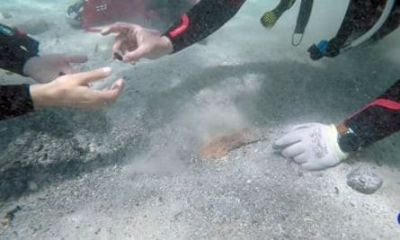An Italian diver’s sighting of something metallic near the coast of Sardinia has led to the discovery of tens of thousands of Roman bronze coins, Italy’s culture ministry has said. After the man alerted the authorities, divers from an art protection squad and the ministry’s undersea archaeology department were sent to investigate. The coins, which date back to the first half of the fourth century, were found among sea grass not far from the northeast shore of the Mediterranean island. The exact date of the initial sighting has not been disclosed by the ministry, but it was near the town of Arzachena. The number of coins retrieved so far is still being determined as they are now being sorted. It is estimated that there are at least 30,000 coins, and possibly as many as 50,000. The ancient Roman coins recovered are called follis, a bronze coin introduced around 294 AD with the monetary reform of the former Roman emperor Diocletian. Remarkably, all the coins are in an exceptional and rare state of preservation. Even the few coins that were damaged still have legible inscriptions, according to the ministry. Luigi La Rocca, an official from Sardinia’s archaeology department, hailed the find as one of the most significant coin discoveries in recent times.
Secondo il ministro italiano della cultura, un subacqueo italiano ha scoperto decine di migliaia di monete di bronzo nelle coste della Sardegna. Dopo la scoperta, i subacquei di una squadra di protezione artistica e un gruppo di archeologi sono stati mandati per indagare sulla scoperta. Le monete esistono fin dal IV secolo e sono state raccolte tra l’erba marina e non troppo lontano dalla costa nord-orientale dell'isola, vicino il villaggio di Arzachena. Non si conosce la data esatta né la quantità di denaro raccolta. Si stima che esistano almeno 30.000 monete o più di 50.000. Le antiche monete di bronzo, chiamate “follis”, furono dell'imperatore romano Diocleziano nel 294 d.C. Sono ben conservate e anche le monete danneggiate sono ancora in buone condizioni. Secondo il ministro, le iscrizioni possono essere lette. Luigi LaRocca, un archeologo sardo, ha dichiarato che questa scoperta è una delle più incredibili scoperte di monete dei tempi attuali.



